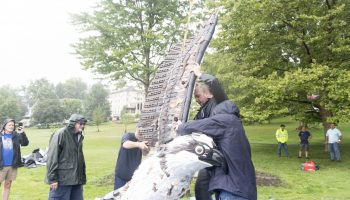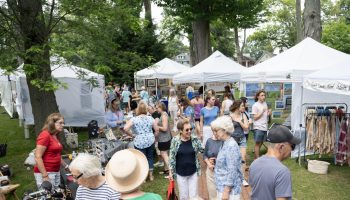Museums often give visitors the magical power to time-travel into past periods, ages and eras. At the Sarasota Art Museum, however, guests are being transported into the future — and identifying with the present.
“Educating the public and helping people find connections and relevancy with contemporary art is really at the core of what we’re trying to do here,” said Virginia Shearer, executive director of the Sarasota Art Museum.
At 5 p.m. Sunday, July 31, in the Hall of Christ, Shearer will give the annual Chautauqua Visual Arts Leon and Gloria Plevin Family Museum Director Lecture. She will discuss the importance of contemporary artists having spaces and platforms to create and showcase new works. She will also talk about fostering an appreciation for art within community settings.

Shearer has over 25 years of experience in museum leadership, and spent about 16 of those years as director of education at the High Museum of Art in Atlanta. In 2021, she became executive director of the Sarasota Museum — a museum simultaneously dedicated to the art of our time and of the future.
Shearer received a master’s in museum education from The George Washington University. She said that her love for museums developed early, in grade school, on a formative trip to the nation’s capital, where she got to tour the Smithsonian National Museum of Natural History and some of America’s other great museums.
In college, while studying overseas in Europe, she visited the Venice Biennale and other famous museums in Italy and France. After graduating from college, she landed a cataloging job at the Albuquerque Museum of Art and History in New Mexico, where she cataloged over 26,000 artifacts in two years.
“Out of the 26,000 total items that we cataloged, the museum placed only about 1,000 of them on view,” she said. “So there were all these objects being hidden away, not ever going to see the light of day.”
Shearer said that this experience galvanized her to pursue a career in museum education, and ultimately inspired her to think about ways to get more objects on display in collections.
Unlike the Albuquerque museum and other American museums, the Sarasota Art Museum doesn’t have a permanent catalog, display or set of archives. Rather, the museum functions as a “kunsthalle” — a non-collecting museum with a rotational catalog, which is popular in Europe. The format parallels the rotational nature of art galleries, providing an opportunity for more items to be on view in museums.
“I think the founders felt that being a contemporary kunsthalle — a space (focused) on the art of today, the moment and the times we were living in — would be a great gift to the community,” she said. “For it not to be something that becomes an archive or a library, rather something that changes, I think that’s what’s super special and exciting about it.”
The exhibition spaces highlight the work of contemporary, emerging and living artists, ranging from about the 1960s to present day. In addition to the exhibition spaces, the museum contains various other spaces: an auditorium, an outdoor sculpture garden, a bistro and a retail store.
“Something that makes me really excited is that we can showcase emerging artists and it may be their first-ever museum exhibition,” Shearer said. “What we are doing seems to be very much in alignment with the artist-in-residence program at Chautauqua. We want to give a shot primarily to living artists because there are often very few opportunities.”
The idea for the museum first formed in the early 2000s. In 2002, 13 core founders and community members originally came up with a plan to repurpose the old and rundown, but beloved and treasured, former Sarasota High School building into a contemporary art museum.
In 2006, the founders partnered with the Ringling College of Art and Design to revitalize the building, preventing it from being torn down. After more than a decade of extensive planning, restoration, and fundraising initiatives, which raised in total over $22 million, the museum finally opened its doors in 2019.
“Ringling College has an extensive public mission of not just being insular and training the next generation of creatives, but making the Sarasota art community better as a whole,” Shearer said. “It sort of seemed like a natural fit that the college would operate a contemporary art museum.”
The marriage between the two entities introduces students to the contemporary art world and artists, and gives community members the opportunity to see students’ work. The space brings members of the community together and is working to put Sarasota on the map, both nationally and internationally.
“It’s a wonderful way of heightening visibility and showing the impact of contemporary art, but also providing opportunities for exposure and in-depth learning,” Shearer said.
Through her work, whether it’s for artists or communities, Shearer said she strives to provide others with access to artistic spaces.
“We’re living at a time when so many people have not had access to art, and maybe their lives could have been different if it were open and accessible,” she said. “A really important part of the work we do in the museum and a driving force in my work professionally is to be as accessible, open, and embracing to new audiences, ideas and perspectives.”




